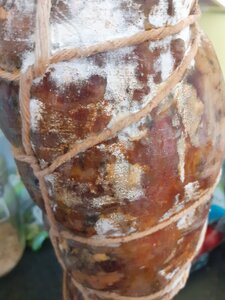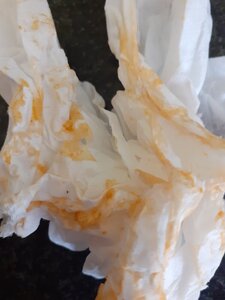- Jul 30, 2017
- 34
- 11
Just noticed some red/brown, almost orange coloured mould on my coppa. A bit powdery, but also slightly sticky. Photos attached. This is a 2 kilo coppa from an organic 30-month old mangolitisa pig! It cost a small fortune, but worse is that it's been drying for three and half months, and has lost 29%. It's almost ready and is my most ambitious project so far. I've wiped it down with vineagar - you can see the colour better on the tissue that I wiped on it. There is nothing in the cure that colour - no paprika, etc, just a bit of fennel seed and black peppercorns (which are the black spots visible through the casing). Humidity has been between around 71% to 78%, and temp at a pretty constant 13 degrees. Any opinions? It would be a real tragedy if I had to throw away this one at this stage.








